Moon Monday #199: Not the fault in our stars but certainly stressful faults on our Moon
Let’s study Moonquakes to not let them shake a Moonbase.
Yes, the headline makes little sense to Google, Web Search Engines, and for SEO. And most likely mainstream social media algorithms don’t care much for it either. Screw them all! And here’s why.
Study Moonquakes to not let them shake a Moonbase
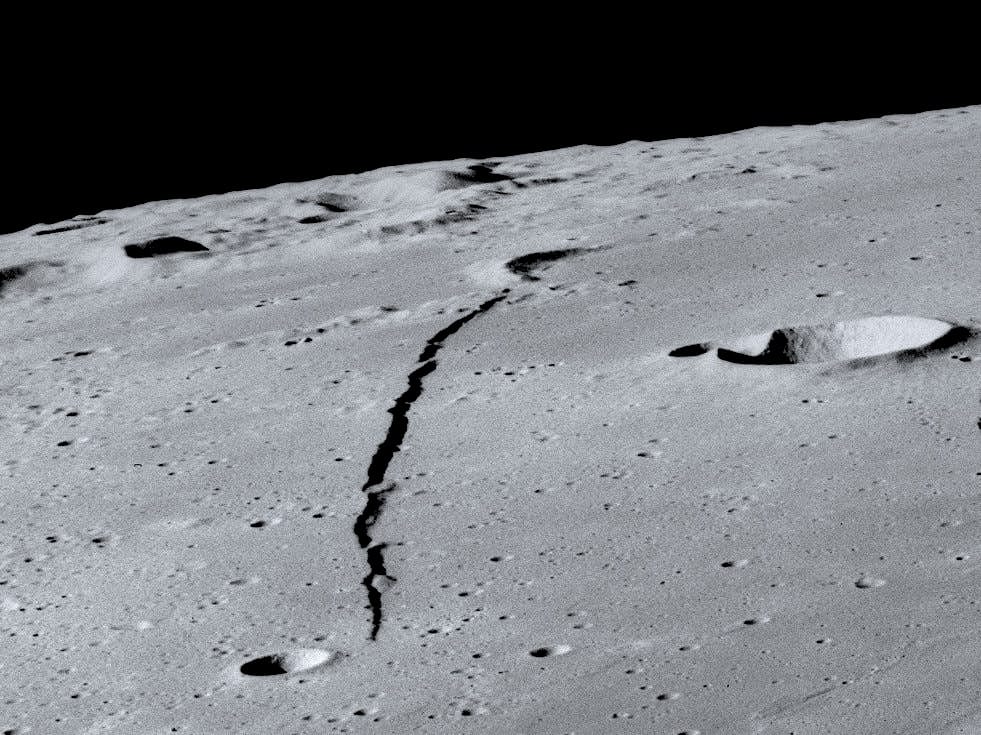
Both the United States and China have set ambitious goals to create a long-term habitat on the Moon’s south pole in the 2030s, respectively called the Artemis Basecamp and the International Lunar Research Station (ILRS). Their surface elements comprise habitat modules, oxygen extractors, water ice miners, solar towers, landing pads, and more such infrastructure pieces. The long-term stability of such habitats, and thus astronaut safety, is unintuitively tied to the fact that our Moon after its fiery formation continues to very gradually cool down and contract. This natural process creates, in direct and indirect ways, stress-induced tectonic features on the lunar surface like faults, valleys, and wrinkled ridges that can be hundreds of kilometers long. These geologically active features, combined with tidal forces from Earth, can cause Moonquakes in various ways. Coupled with loose soil and rock fragments, the quakes can in turn induce landslides in areas with slopes such as crater walls or mountains.
The Apollo Passive Seismic Network, a series of seismometers deployed by astronauts during the Apollo missions, detected over a thousand moonquakes over eight years from across hundreds of locations globally, including many originating from the lunar south pole. A NASA-funded study from January 2024 based on data from Apollo and the Lunar Reconnaissance Orbiter (LRO) found that the Moon’s south polar region experiences shallow moonquakes that can strongly shake the surface, and that its effects can also affect rovers traversing crater slopes in and around permanently shadowed regions, which is where water ice deposits necessary to sustain long-term habitats are thought to exist.
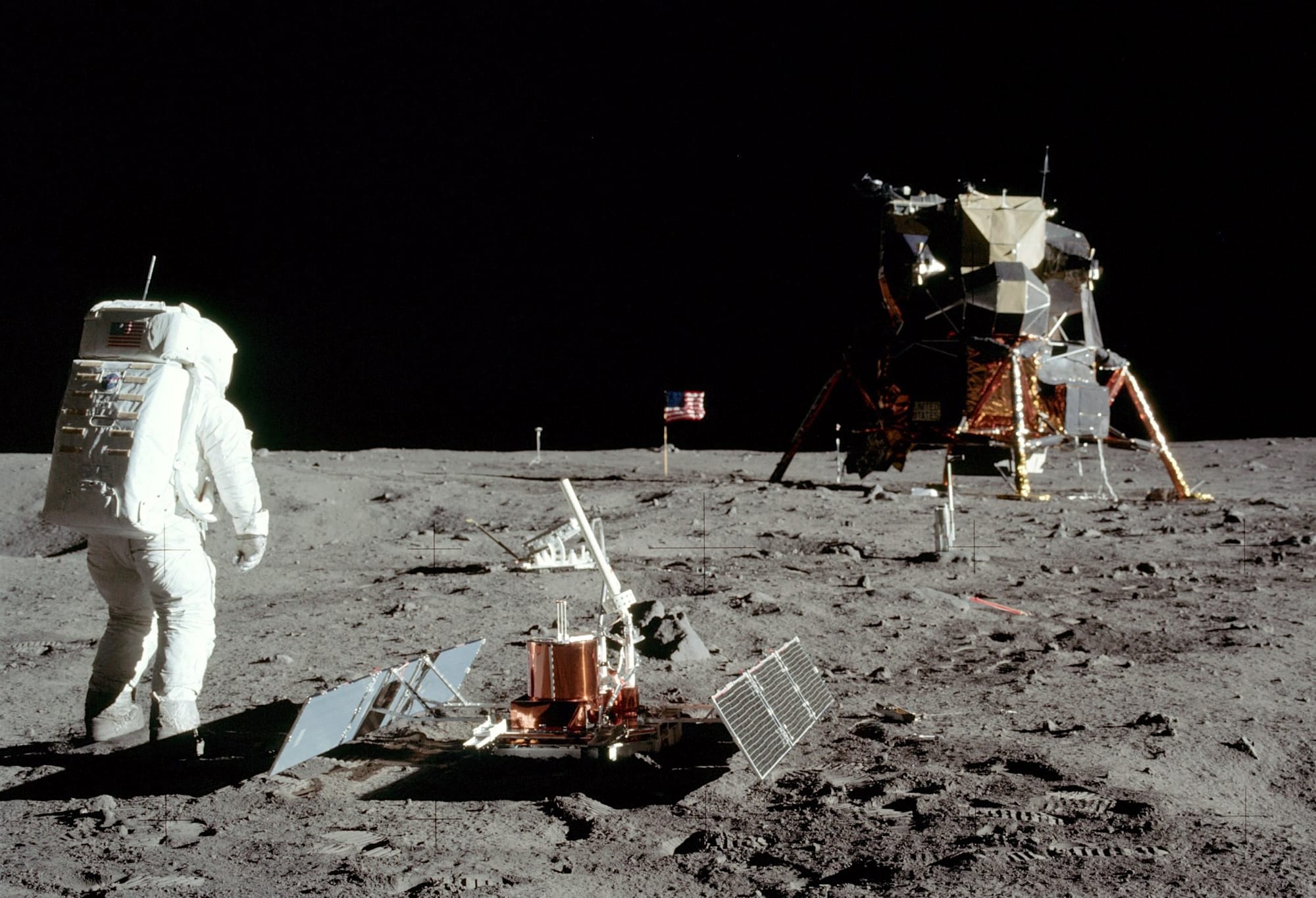
Our Moon’s lower gravity makes experiencing quakes very different than on Earth. Lower gravity means the surface shakes more intensely than terrestrial cases. And, it takes lesser ground motion to overcome gravity’s pull and knock astronauts off their feet—who are in spacesuits which makes walking difficult anyway. Another difference is that it can take up to several hours for energy from lunar seismic events to completely dissipate. This alone could degrade lunar structures and materials faster than on Earth, and is something that will need to be considered for maintenance. Choosing suitable locations for Moonbases thus involve knowing seismic hotspots.
Deploying seismometers on the Moon isn’t just about safe exploration. Data from Apollo seismometers, coupled with data from Apollo’s retroreflectors and magnetometers, have helped scientists infer that our Moon’s core shouldn’t be larger than 900 kilometers. That means the lunar core, solid and liquid combined, represents only about 25 percent of the Moon’s radius—in contrast to about 50 percent for other terrestrial bodies like Earth. Understanding the Moon’s seismic nature will also help advance building gravitational detectors on there in the future.
As such, owning to both safe exploration and good science, we need more missions to study moonquakes and its associated phenomena globally. Here are all the Moon missions that have recently contributed to or hope to contribute to said end.
- Using the 5-meter resolution stereo camera on ISRO’s Chandrayaan 2 orbiter and LRO laser altimeter data, scientists better mapped the structure of the 220-kilometer long Dorsa Geikie wrinkled ridge on the Moon. This gave them better insight into the crustal stresses in the region, when the feature formed, and how our Moon shrinks over time.
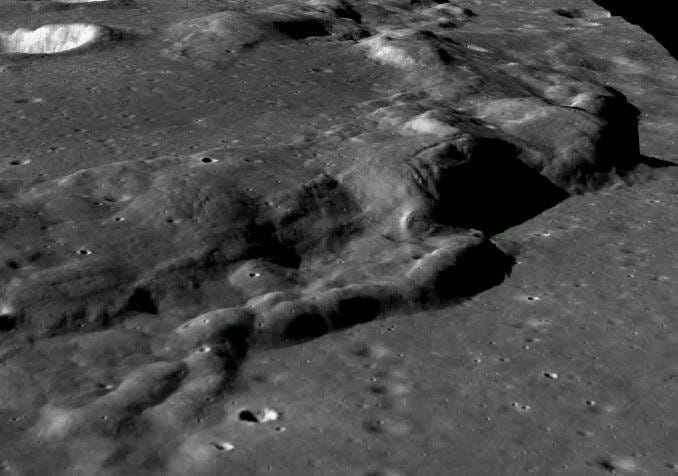
- The seismometer on the Chandrayaan 3 lander, called Instrument for Lunar Seismic Activity (ILSA), was the first since the Apollo era decades ago to measure moonquakes (paper, archived PDF). In the 12 days of its operations from August 24, 2023, ILSA measured 50 seismic events, each lasting several seconds. While ILSA was not meant to detect prolonged deep and shallow moonquakes due to the mission’s design life being just one lunar day, instead of revealing insights about the Moon’s interior it’s helping scientists better understand micrometeorite impacts on the surface at high latitudes. The amount and rate of such impacts is not well constrained at the moment but is necessary to ensure safety of future human lunar polar explorers by designing protective suits and habitats accordingly. Furthermore, ILSA detected 200 signals correlated to known activities of either the lander, its instruments, or traverses of the Chandrayaan 3 rover. Such data will help engineers design safe lunar polar infrastructure.

- Firefly’s second Moon lander, aiming to touchdown on the lunar farside in 2026 as part of NASA’s CLPS program, will commercially carry a seismometer called SPIDER from Australia-based Fleet Space Technologies. In July 2023, the Australian Space Agency funded Fleet Space with $2.4 million as part of its Moon to Mars Demonstrator Grants program to develop SPIDER. In similar vein to the Chandrayaan 3 seismometer, SPIDER will operate for one lunar day and help refine micrometeorite impact rates on the Moon. SPIDER might also offer scientists clues on the structure and nature of the immediate subsurface crust, including hints of resources such as buried water ice.
- The Draper-led, ispace-developed CLPS lander, hoping to launch to the Moon’s farside in 2026, will host two distinct lunar-night-surviving seismometers from NASA and CNES respectively. Called the “Farside Seismic Suite” (FSS), they will operate for more than four months to help scientists better understand the Moon’s internal structure and how it evolved, and know the amount and rate of micrometeorite impacts on the lunar farside in particular—for which we lack data. Both seismometers recently passed the slew of space launch and environmental tests and so are ready to fly to Luna.
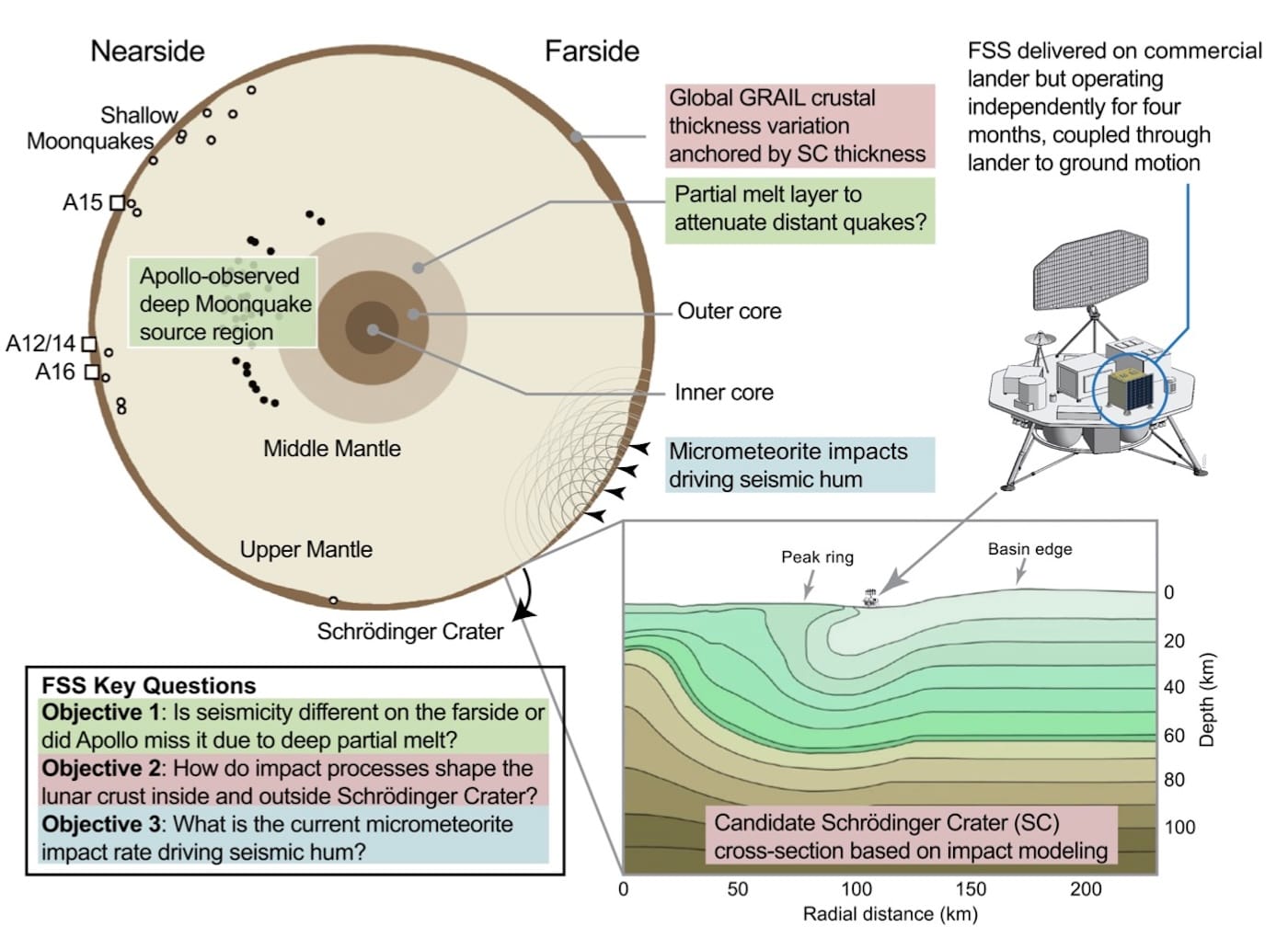
- The upcoming Chinese robotic missions of Chang’e 7 and Chang’e 8 as well NASA’s crewed Artemis III mission will deploy seismometers specifically on the Moon’s south pole. The one on Artemis III will be called Lunar Environment Monitoring Station (LEMS). Together, these seismometers will not only help scientists better understand the structure and nature of the south polar region’s crust and mantle but also determine the rate of seismic activity and micrometeorite impacts on the lunar poles on timescales of several months—and quite possibly more.
All of these missions and more that join the effort in the future can act as efficient enablers in building the proposed Lunar Geophysical Network (LGN) of seismic and other instruments, something which has been recommended in the latest Decadal survey which presents the US research community’s planetary science priorities. LGN seismometers placed across the Moon doing simultaneous detections over years and allowing effective source pinpointing will provide us with a clear picture of the Moon’s entire interior, which is our Solar System’s most pristine example of how insides of planets form and differentiate.
Many thanks to Open Lunar Foundation, David Draper, Gurbir Singh and Jim Singh for sponsoring this week’s Moon Monday! If you too appreciate my efforts to bring you this curated community resource, support my independent writing.
Mission updates
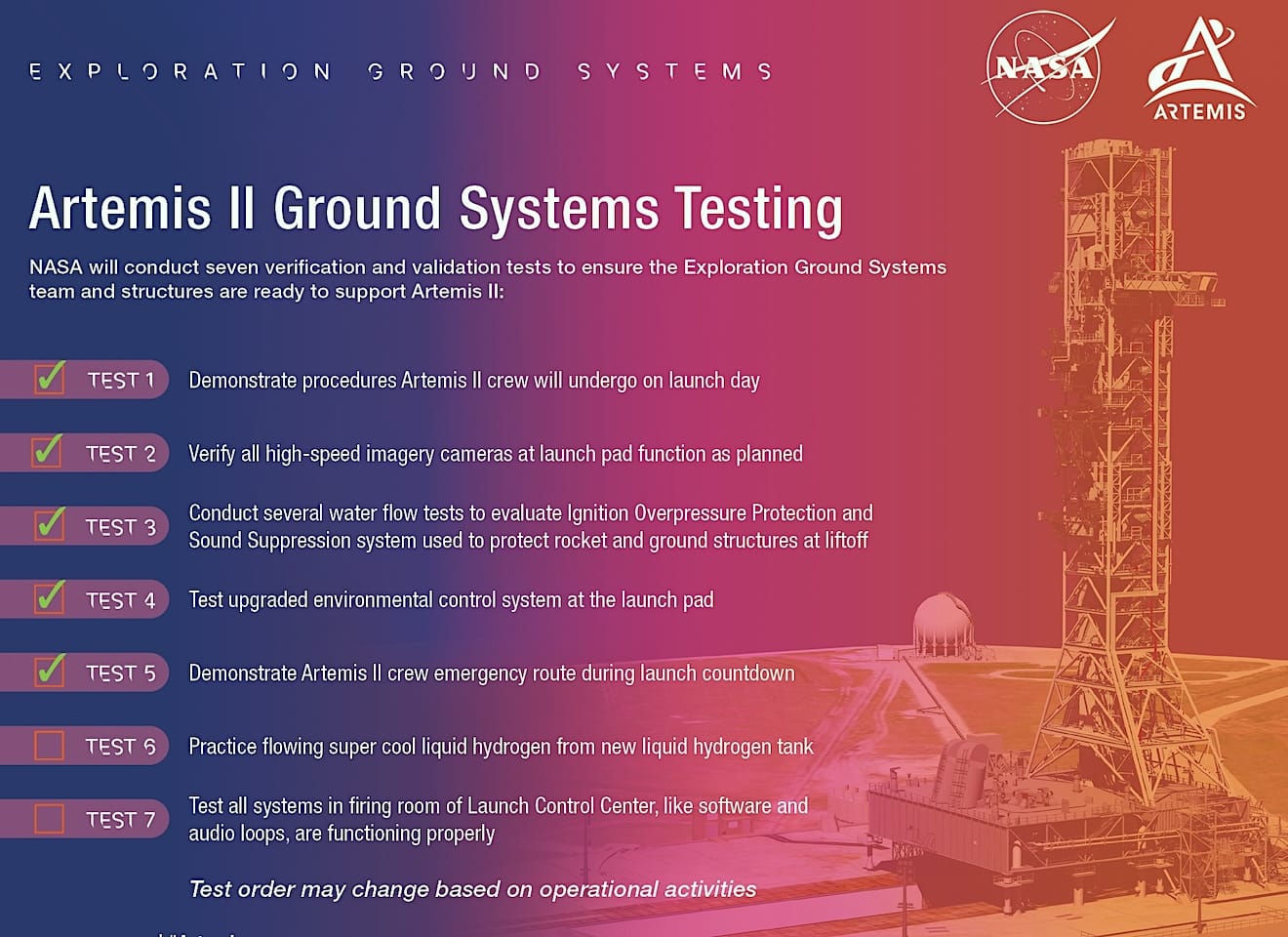
NASA’s Artemis II mission intended to fly four astronauts in an Orion capsule around the Moon and back mid-decade is progressing slowly. Justin Davenport of NASASpaceFlight has provided a good summary of the progress on the SLS rocket that will blast Orion to space:
Artemis II’s core stage, solid rocket booster (SRB) segments, and launch vehicle stage adapter (LVSA) are at the Kennedy Space Center (KSC) and being stored prior to stacking. The core stage and all four RS-25 engines arrived on the barge Pegasus to the KSC turn basin as a unit on July 23 this year while the SRB segments arrived by train to KSC from Utah on Sept. 25, 2023.
The LVSA, fabricated at the Marshall Space Flight Center (MSFC) in Alabama, arrived aboard Pegasus at KSC on July 29, six days after the core stage’s arrival. The core stage is in the VAB transfer aisle and has had its mass and center of gravity measured. The SRB segments are in the rotation, processing, and surge facility (RPSF) while the LVSA is in the VAB’s high bay 4.
The ICPS-2 upper stage, based on the Delta IV second stage, is in the ULA Delta Ops Center at the Cape Canaveral Space Force Station, while the Orion launch abort system (LAS) is in the launch abort system facility at KSC. The only part of the Artemis II SLS launch vehicle that still needs to be delivered is the Orion stage adapter, currently at MSFC, that connects the ICPS to the Orion service module.
Artemis II’s launch is being delayed due to the pending resolution of Orion’s heat shield issues and slow preparations of SLS’ ground systems. On that latter front, teams successfully tested the upgraded environmental control system on the SLS launcher in June. Then there was a successful test of the launch-noise-suppressing water deluge system in July. A major aspect of the emergency escape system was demonstrated in August. More such escape tests will follow, including one with the mission crew before launch.

Jeff Foust reports that Astrolab (a Moon Monday sponsor) is converting a scaled down test model of their crew-capable FLEX rover into a flight rover. Called FLIP, it’s heading for the Moon’s south pole mid-decade—provided Astrolab secures a lander to fly on. The ~500-kilogram rover, which has a payload capacity of 30–50 kilograms, is not that small either. It’s comparable to the ~350-kilogram JAXA-ISRO LUPEX rover in size. By flying FLIP, Astrolab hopes to raise the technology readiness levels of multiple systems also part of FLEX. The latter has a payload capacity north of 1,000 kilograms, and Astrolab leads one of the three competing teams NASA selected earlier this year to mature their designs for a versatile Lunar Terrain Vehicle for use across Artemis missions starting end of decade.
Note that the FLIP rover’s flight is separate from the demonstration FLEX rover Astrolab has hoped to launch before a potential Artemis rover. As Jeff Foust previously reported, the demo FLEX then targeted a 2026 liftoff aboard a SpaceX Lunar Starship, and aims to carry at least eight customer payloads worth $160 million. However, the launch will likely slip because of Starship’s gradual development relative to its marketed timelines.
Also see: 2024’s IAC in Milan had multiple major lunar updates from many countries. Moon Monday #198 has a rundown of them all, contextualized with earlier developments—minus the PR. 🌝
More Moon
- On October 23, the Republic of Cyprus signed the US-led Artemis Accords for cooperative lunar exploration. Chile signed the Accords two days later, becoming the 47th nation in the group. Chile is the eight Latin American country to join the Accords; the others are Brazil, Colombia, Uruguay, Mexico, Argentina, Ecuador, and Peru. Of these, the latter four are members of the recently formed Latin American and Caribbean Space Agency, or ALCE. Inspired in part by the model of the European Space Agency, ALCE aims to pool resources of Latin American nations to enhance their space activities and its impact. Brazil has notably abstained from the initiative.
- The 2024 annual meeting of the NASA-backed Lunar Exploration Analysis Group (LEAG) starts today, October 28. LEAG helps the agency forge and meet its Moon exploration objectives with scientific, technical, commercial, and operational analysis. You can virtually attend LEAG’s annual meet by registering for free.
